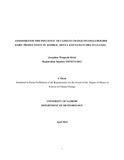| dc.contributor.author | Kirui, Josephine Wangechi | |
| dc.date.accessioned | 2014-07-03T09:25:35Z | |
| dc.date.available | 2014-07-03T09:25:35Z | |
| dc.date.issued | 2014 | |
| dc.identifier.citation | Master of Science in Climate Change | en_US |
| dc.identifier.uri | http://hdl.handle.net/11295/71739 | |
| dc.description.abstract | The influence of climate change in dairy productivity in East Africa is manifested through impacts on fodder production and supply, livestock disease outbreak and water availability for livestock. The overall objective of this study was to assess the influence of climate change on smallholder dairy farming in Kosirai, Nandi district of Kenya and Namayumba in Wakiso district of Uganda, in support of climate smart agricultural practices. Rainfall and temperature variations were the main independent variables of the study. This research was guided by use of cross-sectional survey and Commonwealth Scientific and Industrial Research Organization (CSIRO) Mk3.6 model output. The trend of rainfall and temperature variations was based on both the observed data and CSIRO Mk3.6 model output. A simple random sampling technique was used to select 253 respondents who participated in cross-sectional survey. A validated structured questionnaire with variables on fodder production and availability, milk production, disease outbreak and weather information was used to collect the data. Primary data was analyzed using Statistical Package for Social Sciences (SPSS). Time series climate data was obtained using observed and CSIRO Mk3.6 model output.
The study found out that the mean rainfall in the two study sites had progressively decreased over the last 10 years. Conversely there was a systematic rise in both the minimum and maximum temperature, both in historical and projected period in the two sites. The climate perturbations had positive correlation with fodder production and supply. Likewise milk production that mainly depended on rain fed forages also correlated with supply of feeds. There was increased milk production and supply during the wet season as compared to the dry spells.
Climate change has resulted in the emergence and rise of both the vector born and viral diseases in the two sites. There was significant rise in out breaks of foot and mouth disease and tick borne diseases in Namayumba area. In Kosirai there was an increase in outbreaks of tick borne. The study recommended that dairy farmers be empowered to effectively prepare to climate change through adaptation and mitigation of the effect of extreme climate change. Farmers should also invest in the production and conservation of fodder for their dairy production | en_US |
| dc.language.iso | en | en_US |
| dc.publisher | University of Nairobi | en_US |
| dc.title | Assessment of The Influence Of Climate Change On Smallholder Dairy Productivity In Kosirai, Kenya And Namayumba In Uganda | en_US |
| dc.type | Thesis | en_US |

